Comprehensive Analysis of Starbucks' Business Strategy & Global Reach
VerifiedAdded on 2023/06/13
|24
|5952
|319
Report
AI Summary
This report provides a comprehensive analysis of Starbucks' business strategies in the global market. It begins with an industry overview and demand determinants, followed by Porter's Five Forces analysis to assess the competitive landscape. The report then examines Starbucks' strategic positioning using the strategy clock, internal analysis, and VRIO framework to identify core competencies. Key strategies, including differentiation focus, are discussed, along with Ansoff matrix applications. The report concludes with recommendations for sustaining market position, emphasizing fair trade practices, employee motivation, and continuous innovation in products and services.
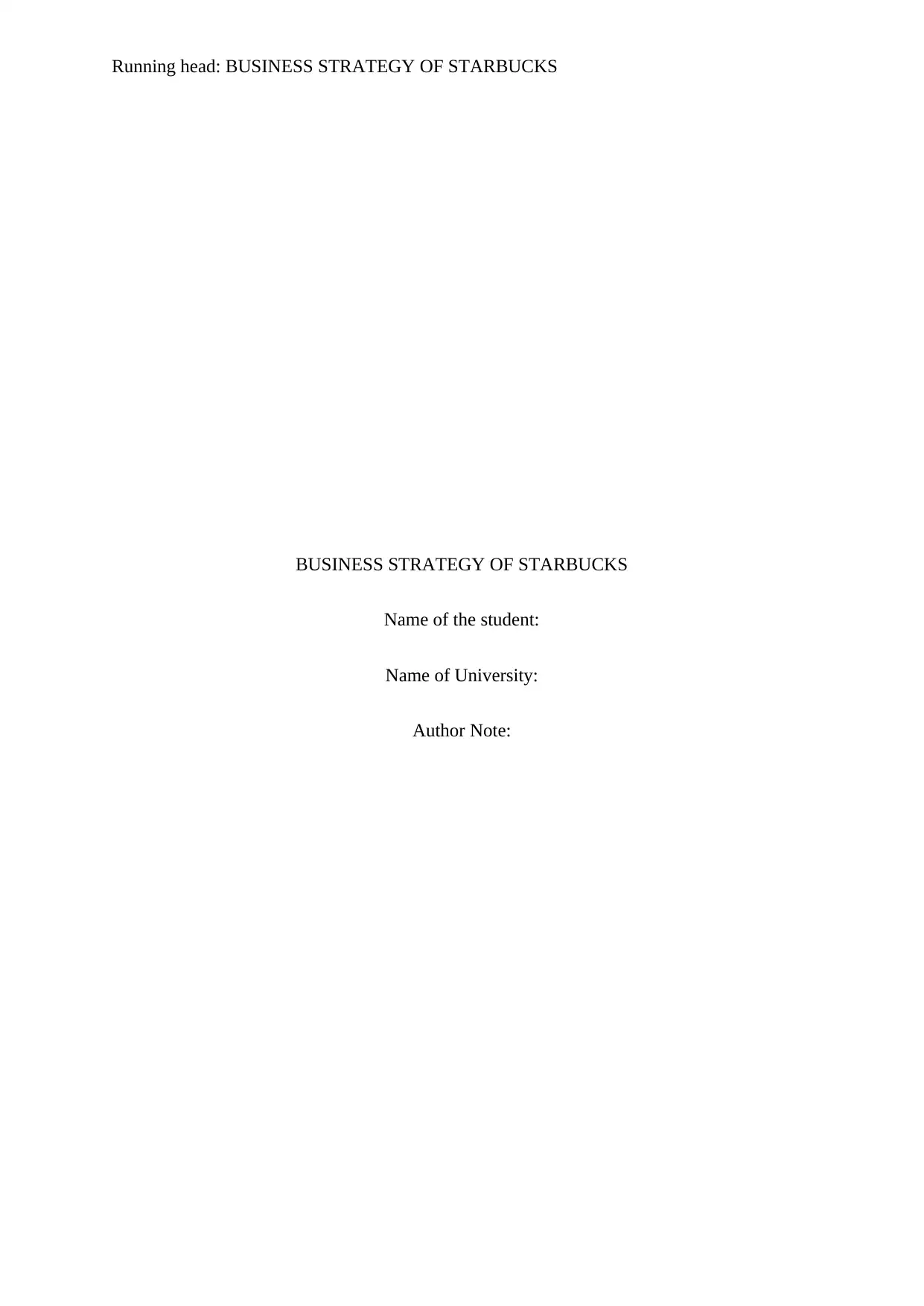
Running head: BUSINESS STRATEGY OF STARBUCKS
BUSINESS STRATEGY OF STARBUCKS
Name of the student:
Name of University:
Author Note:
BUSINESS STRATEGY OF STARBUCKS
Name of the student:
Name of University:
Author Note:
Paraphrase This Document
Need a fresh take? Get an instant paraphrase of this document with our AI Paraphraser
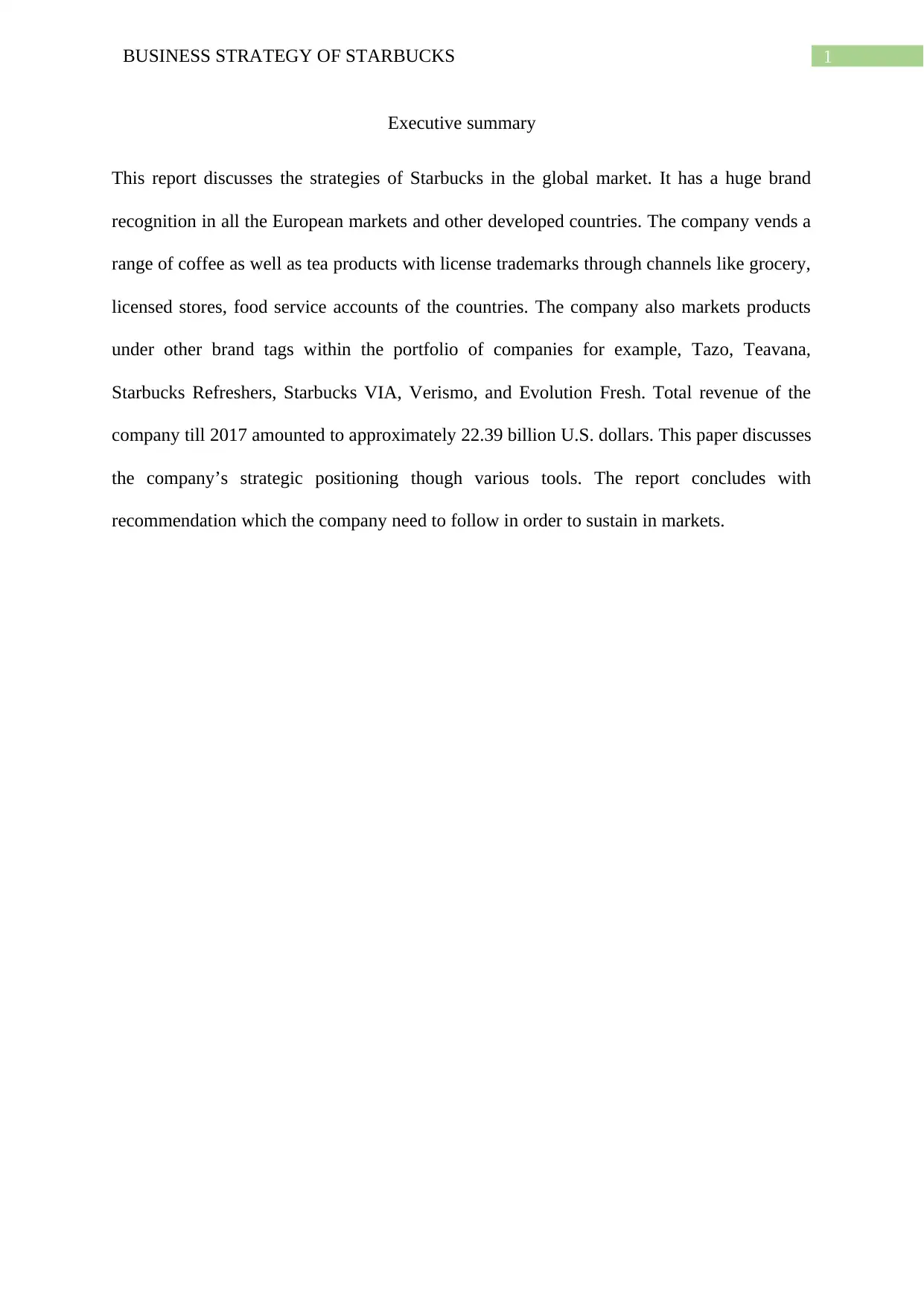
1BUSINESS STRATEGY OF STARBUCKS
Executive summary
This report discusses the strategies of Starbucks in the global market. It has a huge brand
recognition in all the European markets and other developed countries. The company vends a
range of coffee as well as tea products with license trademarks through channels like grocery,
licensed stores, food service accounts of the countries. The company also markets products
under other brand tags within the portfolio of companies for example, Tazo, Teavana,
Starbucks Refreshers, Starbucks VIA, Verismo, and Evolution Fresh. Total revenue of the
company till 2017 amounted to approximately 22.39 billion U.S. dollars. This paper discusses
the company’s strategic positioning though various tools. The report concludes with
recommendation which the company need to follow in order to sustain in markets.
Executive summary
This report discusses the strategies of Starbucks in the global market. It has a huge brand
recognition in all the European markets and other developed countries. The company vends a
range of coffee as well as tea products with license trademarks through channels like grocery,
licensed stores, food service accounts of the countries. The company also markets products
under other brand tags within the portfolio of companies for example, Tazo, Teavana,
Starbucks Refreshers, Starbucks VIA, Verismo, and Evolution Fresh. Total revenue of the
company till 2017 amounted to approximately 22.39 billion U.S. dollars. This paper discusses
the company’s strategic positioning though various tools. The report concludes with
recommendation which the company need to follow in order to sustain in markets.
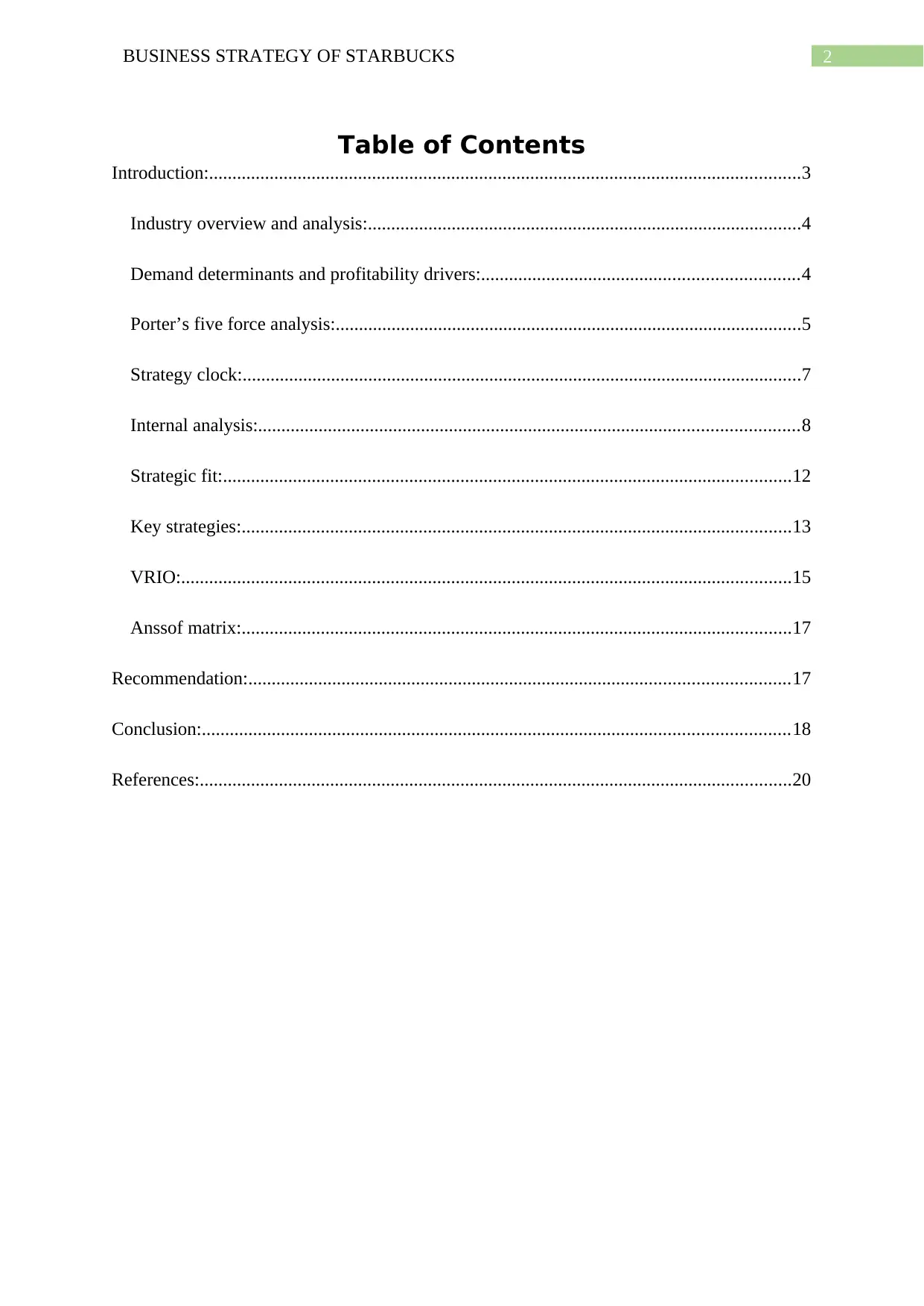
2BUSINESS STRATEGY OF STARBUCKS
Table of Contents
Introduction:...............................................................................................................................3
Industry overview and analysis:.............................................................................................4
Demand determinants and profitability drivers:....................................................................4
Porter’s five force analysis:....................................................................................................5
Strategy clock:........................................................................................................................7
Internal analysis:....................................................................................................................8
Strategic fit:..........................................................................................................................12
Key strategies:......................................................................................................................13
VRIO:...................................................................................................................................15
Anssof matrix:......................................................................................................................17
Recommendation:....................................................................................................................17
Conclusion:..............................................................................................................................18
References:...............................................................................................................................20
Table of Contents
Introduction:...............................................................................................................................3
Industry overview and analysis:.............................................................................................4
Demand determinants and profitability drivers:....................................................................4
Porter’s five force analysis:....................................................................................................5
Strategy clock:........................................................................................................................7
Internal analysis:....................................................................................................................8
Strategic fit:..........................................................................................................................12
Key strategies:......................................................................................................................13
VRIO:...................................................................................................................................15
Anssof matrix:......................................................................................................................17
Recommendation:....................................................................................................................17
Conclusion:..............................................................................................................................18
References:...............................................................................................................................20
⊘ This is a preview!⊘
Do you want full access?
Subscribe today to unlock all pages.

Trusted by 1+ million students worldwide
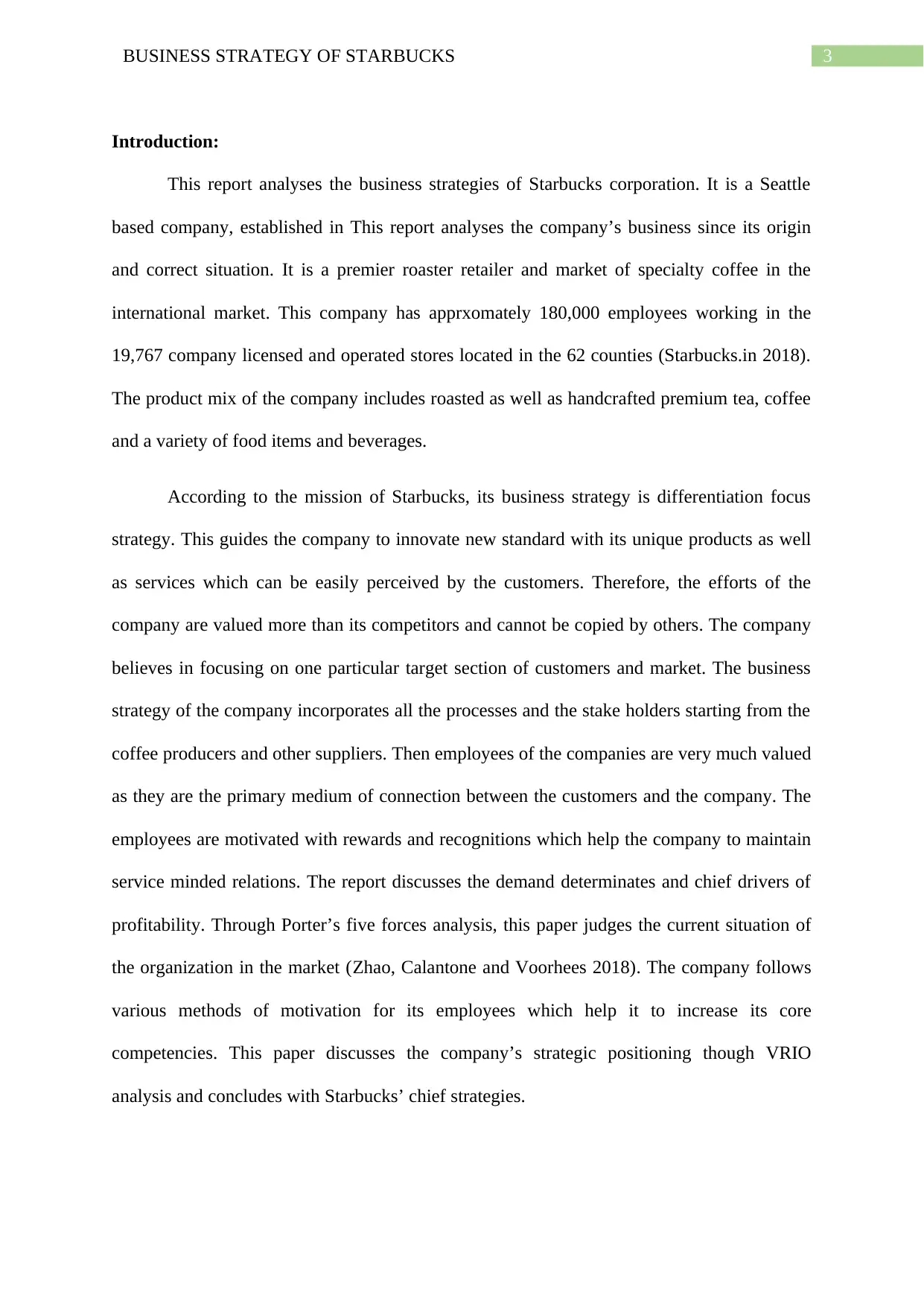
3BUSINESS STRATEGY OF STARBUCKS
Introduction:
This report analyses the business strategies of Starbucks corporation. It is a Seattle
based company, established in This report analyses the company’s business since its origin
and correct situation. It is a premier roaster retailer and market of specialty coffee in the
international market. This company has apprxomately 180,000 employees working in the
19,767 company licensed and operated stores located in the 62 counties (Starbucks.in 2018).
The product mix of the company includes roasted as well as handcrafted premium tea, coffee
and a variety of food items and beverages.
According to the mission of Starbucks, its business strategy is differentiation focus
strategy. This guides the company to innovate new standard with its unique products as well
as services which can be easily perceived by the customers. Therefore, the efforts of the
company are valued more than its competitors and cannot be copied by others. The company
believes in focusing on one particular target section of customers and market. The business
strategy of the company incorporates all the processes and the stake holders starting from the
coffee producers and other suppliers. Then employees of the companies are very much valued
as they are the primary medium of connection between the customers and the company. The
employees are motivated with rewards and recognitions which help the company to maintain
service minded relations. The report discusses the demand determinates and chief drivers of
profitability. Through Porter’s five forces analysis, this paper judges the current situation of
the organization in the market (Zhao, Calantone and Voorhees 2018). The company follows
various methods of motivation for its employees which help it to increase its core
competencies. This paper discusses the company’s strategic positioning though VRIO
analysis and concludes with Starbucks’ chief strategies.
Introduction:
This report analyses the business strategies of Starbucks corporation. It is a Seattle
based company, established in This report analyses the company’s business since its origin
and correct situation. It is a premier roaster retailer and market of specialty coffee in the
international market. This company has apprxomately 180,000 employees working in the
19,767 company licensed and operated stores located in the 62 counties (Starbucks.in 2018).
The product mix of the company includes roasted as well as handcrafted premium tea, coffee
and a variety of food items and beverages.
According to the mission of Starbucks, its business strategy is differentiation focus
strategy. This guides the company to innovate new standard with its unique products as well
as services which can be easily perceived by the customers. Therefore, the efforts of the
company are valued more than its competitors and cannot be copied by others. The company
believes in focusing on one particular target section of customers and market. The business
strategy of the company incorporates all the processes and the stake holders starting from the
coffee producers and other suppliers. Then employees of the companies are very much valued
as they are the primary medium of connection between the customers and the company. The
employees are motivated with rewards and recognitions which help the company to maintain
service minded relations. The report discusses the demand determinates and chief drivers of
profitability. Through Porter’s five forces analysis, this paper judges the current situation of
the organization in the market (Zhao, Calantone and Voorhees 2018). The company follows
various methods of motivation for its employees which help it to increase its core
competencies. This paper discusses the company’s strategic positioning though VRIO
analysis and concludes with Starbucks’ chief strategies.
Paraphrase This Document
Need a fresh take? Get an instant paraphrase of this document with our AI Paraphraser
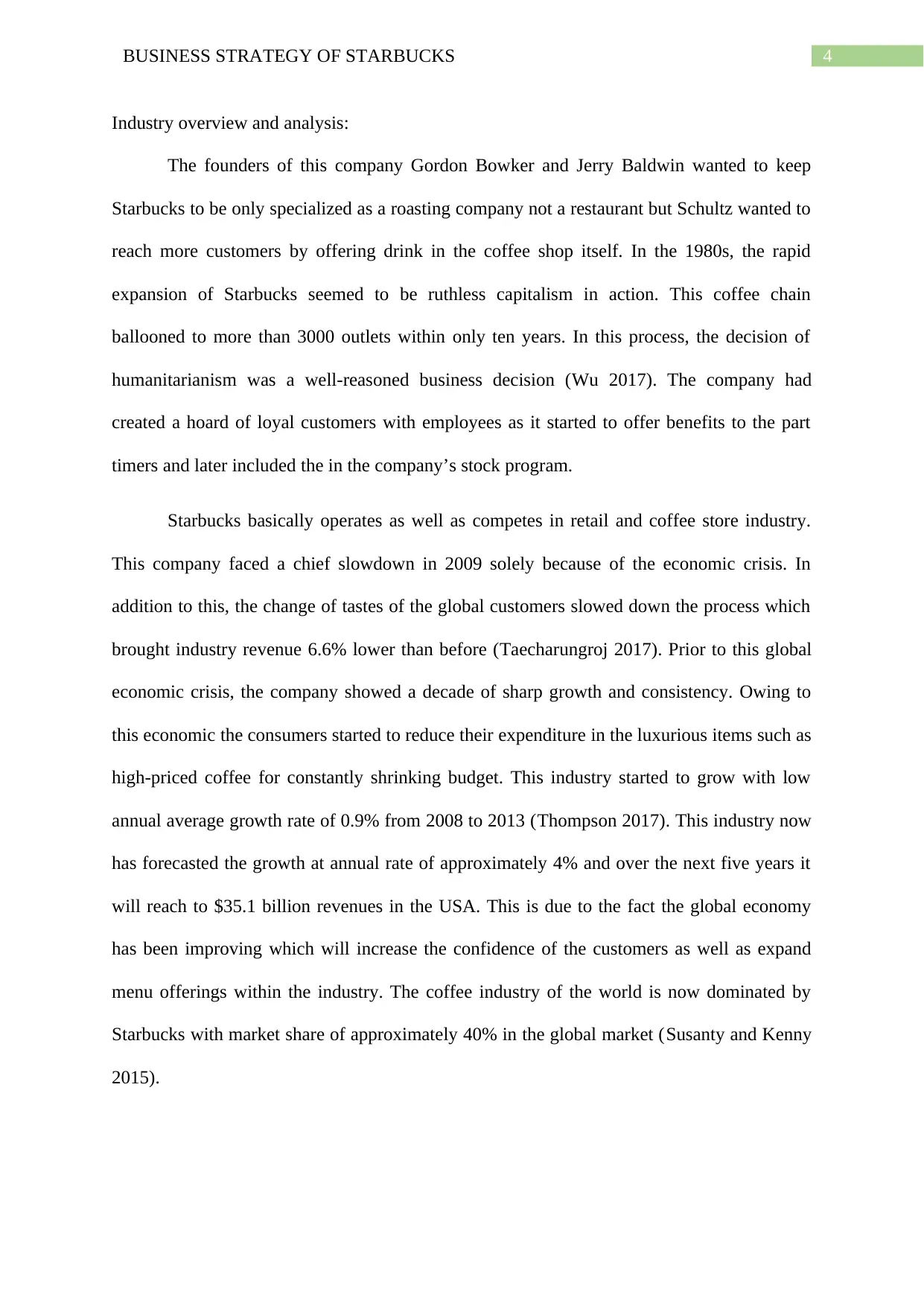
4BUSINESS STRATEGY OF STARBUCKS
Industry overview and analysis:
The founders of this company Gordon Bowker and Jerry Baldwin wanted to keep
Starbucks to be only specialized as a roasting company not a restaurant but Schultz wanted to
reach more customers by offering drink in the coffee shop itself. In the 1980s, the rapid
expansion of Starbucks seemed to be ruthless capitalism in action. This coffee chain
ballooned to more than 3000 outlets within only ten years. In this process, the decision of
humanitarianism was a well-reasoned business decision (Wu 2017). The company had
created a hoard of loyal customers with employees as it started to offer benefits to the part
timers and later included the in the company’s stock program.
Starbucks basically operates as well as competes in retail and coffee store industry.
This company faced a chief slowdown in 2009 solely because of the economic crisis. In
addition to this, the change of tastes of the global customers slowed down the process which
brought industry revenue 6.6% lower than before (Taecharungroj 2017). Prior to this global
economic crisis, the company showed a decade of sharp growth and consistency. Owing to
this economic the consumers started to reduce their expenditure in the luxurious items such as
high-priced coffee for constantly shrinking budget. This industry started to grow with low
annual average growth rate of 0.9% from 2008 to 2013 (Thompson 2017). This industry now
has forecasted the growth at annual rate of approximately 4% and over the next five years it
will reach to $35.1 billion revenues in the USA. This is due to the fact the global economy
has been improving which will increase the confidence of the customers as well as expand
menu offerings within the industry. The coffee industry of the world is now dominated by
Starbucks with market share of approximately 40% in the global market (Susanty and Kenny
2015).
Industry overview and analysis:
The founders of this company Gordon Bowker and Jerry Baldwin wanted to keep
Starbucks to be only specialized as a roasting company not a restaurant but Schultz wanted to
reach more customers by offering drink in the coffee shop itself. In the 1980s, the rapid
expansion of Starbucks seemed to be ruthless capitalism in action. This coffee chain
ballooned to more than 3000 outlets within only ten years. In this process, the decision of
humanitarianism was a well-reasoned business decision (Wu 2017). The company had
created a hoard of loyal customers with employees as it started to offer benefits to the part
timers and later included the in the company’s stock program.
Starbucks basically operates as well as competes in retail and coffee store industry.
This company faced a chief slowdown in 2009 solely because of the economic crisis. In
addition to this, the change of tastes of the global customers slowed down the process which
brought industry revenue 6.6% lower than before (Taecharungroj 2017). Prior to this global
economic crisis, the company showed a decade of sharp growth and consistency. Owing to
this economic the consumers started to reduce their expenditure in the luxurious items such as
high-priced coffee for constantly shrinking budget. This industry started to grow with low
annual average growth rate of 0.9% from 2008 to 2013 (Thompson 2017). This industry now
has forecasted the growth at annual rate of approximately 4% and over the next five years it
will reach to $35.1 billion revenues in the USA. This is due to the fact the global economy
has been improving which will increase the confidence of the customers as well as expand
menu offerings within the industry. The coffee industry of the world is now dominated by
Starbucks with market share of approximately 40% in the global market (Susanty and Kenny
2015).
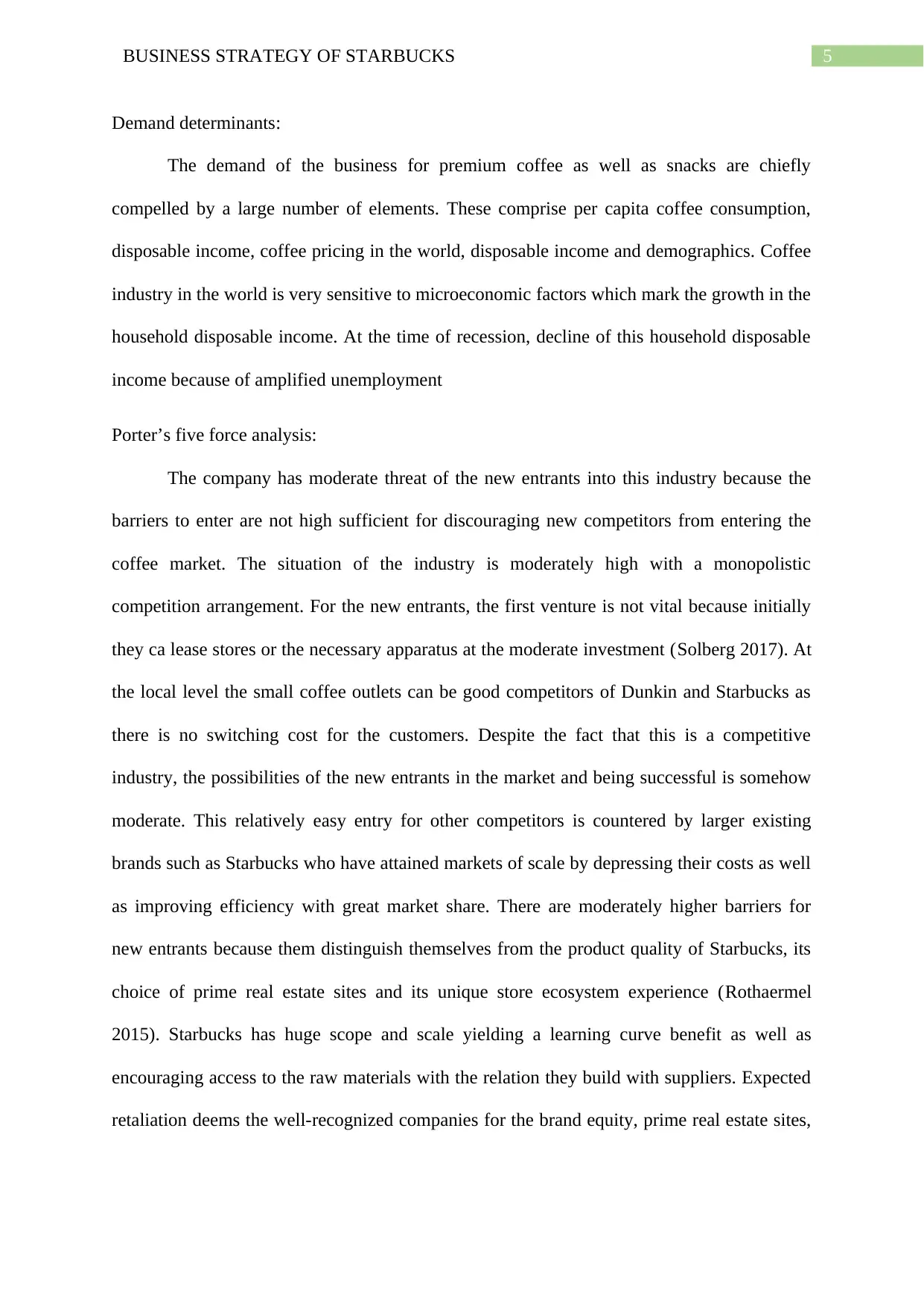
5BUSINESS STRATEGY OF STARBUCKS
Demand determinants:
The demand of the business for premium coffee as well as snacks are chiefly
compelled by a large number of elements. These comprise per capita coffee consumption,
disposable income, coffee pricing in the world, disposable income and demographics. Coffee
industry in the world is very sensitive to microeconomic factors which mark the growth in the
household disposable income. At the time of recession, decline of this household disposable
income because of amplified unemployment
Porter’s five force analysis:
The company has moderate threat of the new entrants into this industry because the
barriers to enter are not high sufficient for discouraging new competitors from entering the
coffee market. The situation of the industry is moderately high with a monopolistic
competition arrangement. For the new entrants, the first venture is not vital because initially
they ca lease stores or the necessary apparatus at the moderate investment (Solberg 2017). At
the local level the small coffee outlets can be good competitors of Dunkin and Starbucks as
there is no switching cost for the customers. Despite the fact that this is a competitive
industry, the possibilities of the new entrants in the market and being successful is somehow
moderate. This relatively easy entry for other competitors is countered by larger existing
brands such as Starbucks who have attained markets of scale by depressing their costs as well
as improving efficiency with great market share. There are moderately higher barriers for
new entrants because them distinguish themselves from the product quality of Starbucks, its
choice of prime real estate sites and its unique store ecosystem experience (Rothaermel
2015). Starbucks has huge scope and scale yielding a learning curve benefit as well as
encouraging access to the raw materials with the relation they build with suppliers. Expected
retaliation deems the well-recognized companies for the brand equity, prime real estate sites,
Demand determinants:
The demand of the business for premium coffee as well as snacks are chiefly
compelled by a large number of elements. These comprise per capita coffee consumption,
disposable income, coffee pricing in the world, disposable income and demographics. Coffee
industry in the world is very sensitive to microeconomic factors which mark the growth in the
household disposable income. At the time of recession, decline of this household disposable
income because of amplified unemployment
Porter’s five force analysis:
The company has moderate threat of the new entrants into this industry because the
barriers to enter are not high sufficient for discouraging new competitors from entering the
coffee market. The situation of the industry is moderately high with a monopolistic
competition arrangement. For the new entrants, the first venture is not vital because initially
they ca lease stores or the necessary apparatus at the moderate investment (Solberg 2017). At
the local level the small coffee outlets can be good competitors of Dunkin and Starbucks as
there is no switching cost for the customers. Despite the fact that this is a competitive
industry, the possibilities of the new entrants in the market and being successful is somehow
moderate. This relatively easy entry for other competitors is countered by larger existing
brands such as Starbucks who have attained markets of scale by depressing their costs as well
as improving efficiency with great market share. There are moderately higher barriers for
new entrants because them distinguish themselves from the product quality of Starbucks, its
choice of prime real estate sites and its unique store ecosystem experience (Rothaermel
2015). Starbucks has huge scope and scale yielding a learning curve benefit as well as
encouraging access to the raw materials with the relation they build with suppliers. Expected
retaliation deems the well-recognized companies for the brand equity, prime real estate sites,
⊘ This is a preview!⊘
Do you want full access?
Subscribe today to unlock all pages.

Trusted by 1+ million students worldwide
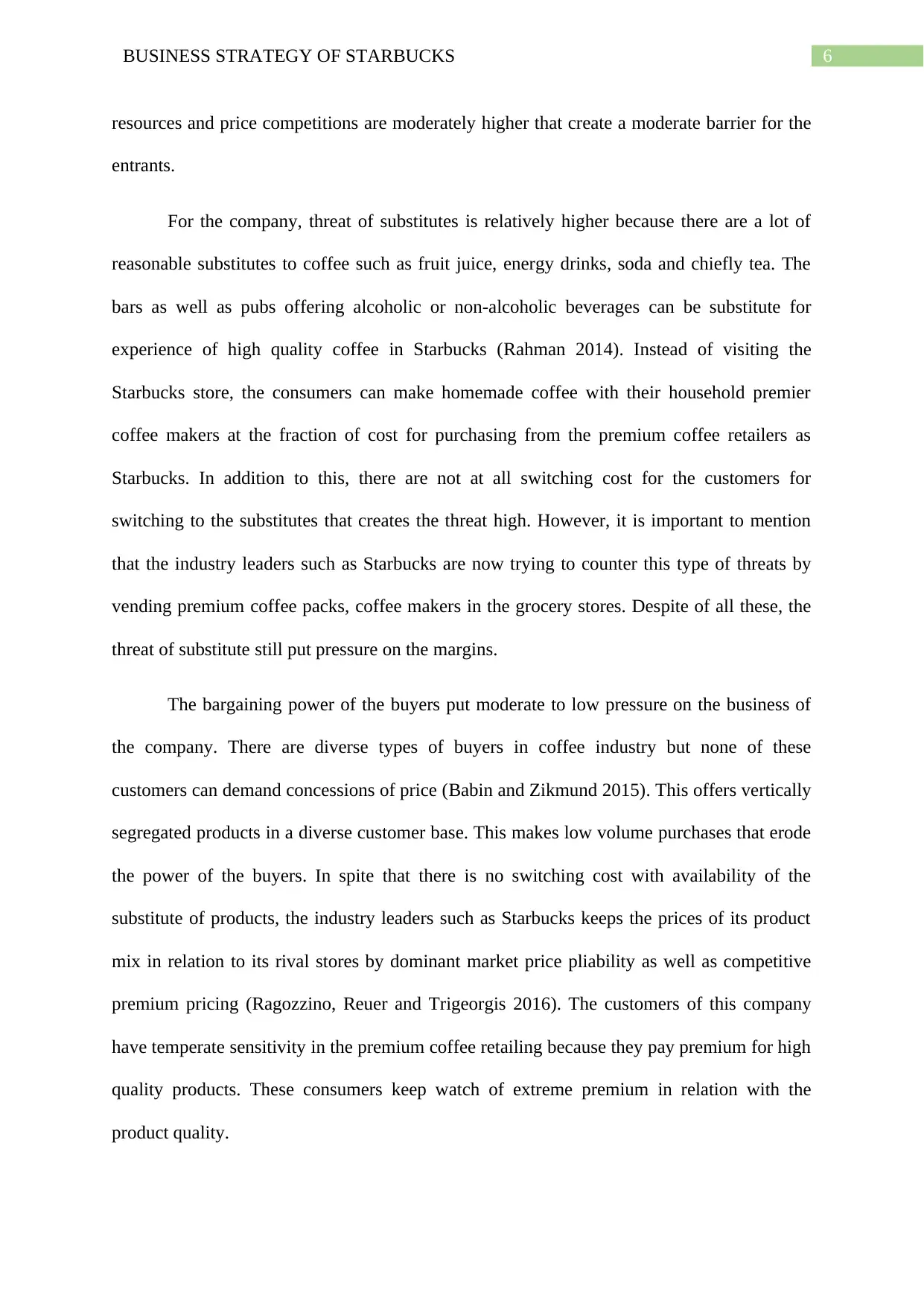
6BUSINESS STRATEGY OF STARBUCKS
resources and price competitions are moderately higher that create a moderate barrier for the
entrants.
For the company, threat of substitutes is relatively higher because there are a lot of
reasonable substitutes to coffee such as fruit juice, energy drinks, soda and chiefly tea. The
bars as well as pubs offering alcoholic or non-alcoholic beverages can be substitute for
experience of high quality coffee in Starbucks (Rahman 2014). Instead of visiting the
Starbucks store, the consumers can make homemade coffee with their household premier
coffee makers at the fraction of cost for purchasing from the premium coffee retailers as
Starbucks. In addition to this, there are not at all switching cost for the customers for
switching to the substitutes that creates the threat high. However, it is important to mention
that the industry leaders such as Starbucks are now trying to counter this type of threats by
vending premium coffee packs, coffee makers in the grocery stores. Despite of all these, the
threat of substitute still put pressure on the margins.
The bargaining power of the buyers put moderate to low pressure on the business of
the company. There are diverse types of buyers in coffee industry but none of these
customers can demand concessions of price (Babin and Zikmund 2015). This offers vertically
segregated products in a diverse customer base. This makes low volume purchases that erode
the power of the buyers. In spite that there is no switching cost with availability of the
substitute of products, the industry leaders such as Starbucks keeps the prices of its product
mix in relation to its rival stores by dominant market price pliability as well as competitive
premium pricing (Ragozzino, Reuer and Trigeorgis 2016). The customers of this company
have temperate sensitivity in the premium coffee retailing because they pay premium for high
quality products. These consumers keep watch of extreme premium in relation with the
product quality.
resources and price competitions are moderately higher that create a moderate barrier for the
entrants.
For the company, threat of substitutes is relatively higher because there are a lot of
reasonable substitutes to coffee such as fruit juice, energy drinks, soda and chiefly tea. The
bars as well as pubs offering alcoholic or non-alcoholic beverages can be substitute for
experience of high quality coffee in Starbucks (Rahman 2014). Instead of visiting the
Starbucks store, the consumers can make homemade coffee with their household premier
coffee makers at the fraction of cost for purchasing from the premium coffee retailers as
Starbucks. In addition to this, there are not at all switching cost for the customers for
switching to the substitutes that creates the threat high. However, it is important to mention
that the industry leaders such as Starbucks are now trying to counter this type of threats by
vending premium coffee packs, coffee makers in the grocery stores. Despite of all these, the
threat of substitute still put pressure on the margins.
The bargaining power of the buyers put moderate to low pressure on the business of
the company. There are diverse types of buyers in coffee industry but none of these
customers can demand concessions of price (Babin and Zikmund 2015). This offers vertically
segregated products in a diverse customer base. This makes low volume purchases that erode
the power of the buyers. In spite that there is no switching cost with availability of the
substitute of products, the industry leaders such as Starbucks keeps the prices of its product
mix in relation to its rival stores by dominant market price pliability as well as competitive
premium pricing (Ragozzino, Reuer and Trigeorgis 2016). The customers of this company
have temperate sensitivity in the premium coffee retailing because they pay premium for high
quality products. These consumers keep watch of extreme premium in relation with the
product quality.
Paraphrase This Document
Need a fresh take? Get an instant paraphrase of this document with our AI Paraphraser
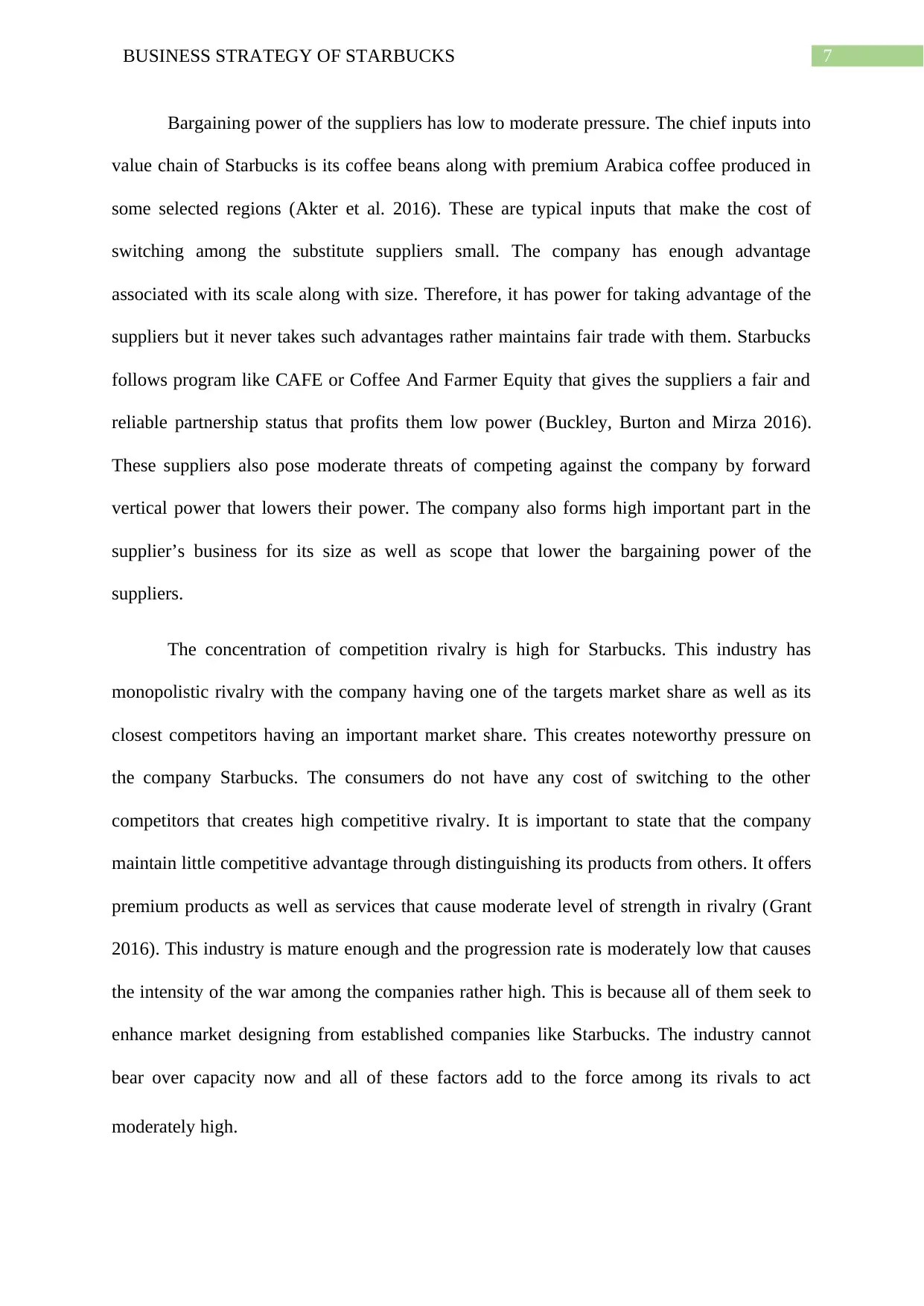
7BUSINESS STRATEGY OF STARBUCKS
Bargaining power of the suppliers has low to moderate pressure. The chief inputs into
value chain of Starbucks is its coffee beans along with premium Arabica coffee produced in
some selected regions (Akter et al. 2016). These are typical inputs that make the cost of
switching among the substitute suppliers small. The company has enough advantage
associated with its scale along with size. Therefore, it has power for taking advantage of the
suppliers but it never takes such advantages rather maintains fair trade with them. Starbucks
follows program like CAFE or Coffee And Farmer Equity that gives the suppliers a fair and
reliable partnership status that profits them low power (Buckley, Burton and Mirza 2016).
These suppliers also pose moderate threats of competing against the company by forward
vertical power that lowers their power. The company also forms high important part in the
supplier’s business for its size as well as scope that lower the bargaining power of the
suppliers.
The concentration of competition rivalry is high for Starbucks. This industry has
monopolistic rivalry with the company having one of the targets market share as well as its
closest competitors having an important market share. This creates noteworthy pressure on
the company Starbucks. The consumers do not have any cost of switching to the other
competitors that creates high competitive rivalry. It is important to state that the company
maintain little competitive advantage through distinguishing its products from others. It offers
premium products as well as services that cause moderate level of strength in rivalry (Grant
2016). This industry is mature enough and the progression rate is moderately low that causes
the intensity of the war among the companies rather high. This is because all of them seek to
enhance market designing from established companies like Starbucks. The industry cannot
bear over capacity now and all of these factors add to the force among its rivals to act
moderately high.
Bargaining power of the suppliers has low to moderate pressure. The chief inputs into
value chain of Starbucks is its coffee beans along with premium Arabica coffee produced in
some selected regions (Akter et al. 2016). These are typical inputs that make the cost of
switching among the substitute suppliers small. The company has enough advantage
associated with its scale along with size. Therefore, it has power for taking advantage of the
suppliers but it never takes such advantages rather maintains fair trade with them. Starbucks
follows program like CAFE or Coffee And Farmer Equity that gives the suppliers a fair and
reliable partnership status that profits them low power (Buckley, Burton and Mirza 2016).
These suppliers also pose moderate threats of competing against the company by forward
vertical power that lowers their power. The company also forms high important part in the
supplier’s business for its size as well as scope that lower the bargaining power of the
suppliers.
The concentration of competition rivalry is high for Starbucks. This industry has
monopolistic rivalry with the company having one of the targets market share as well as its
closest competitors having an important market share. This creates noteworthy pressure on
the company Starbucks. The consumers do not have any cost of switching to the other
competitors that creates high competitive rivalry. It is important to state that the company
maintain little competitive advantage through distinguishing its products from others. It offers
premium products as well as services that cause moderate level of strength in rivalry (Grant
2016). This industry is mature enough and the progression rate is moderately low that causes
the intensity of the war among the companies rather high. This is because all of them seek to
enhance market designing from established companies like Starbucks. The industry cannot
bear over capacity now and all of these factors add to the force among its rivals to act
moderately high.
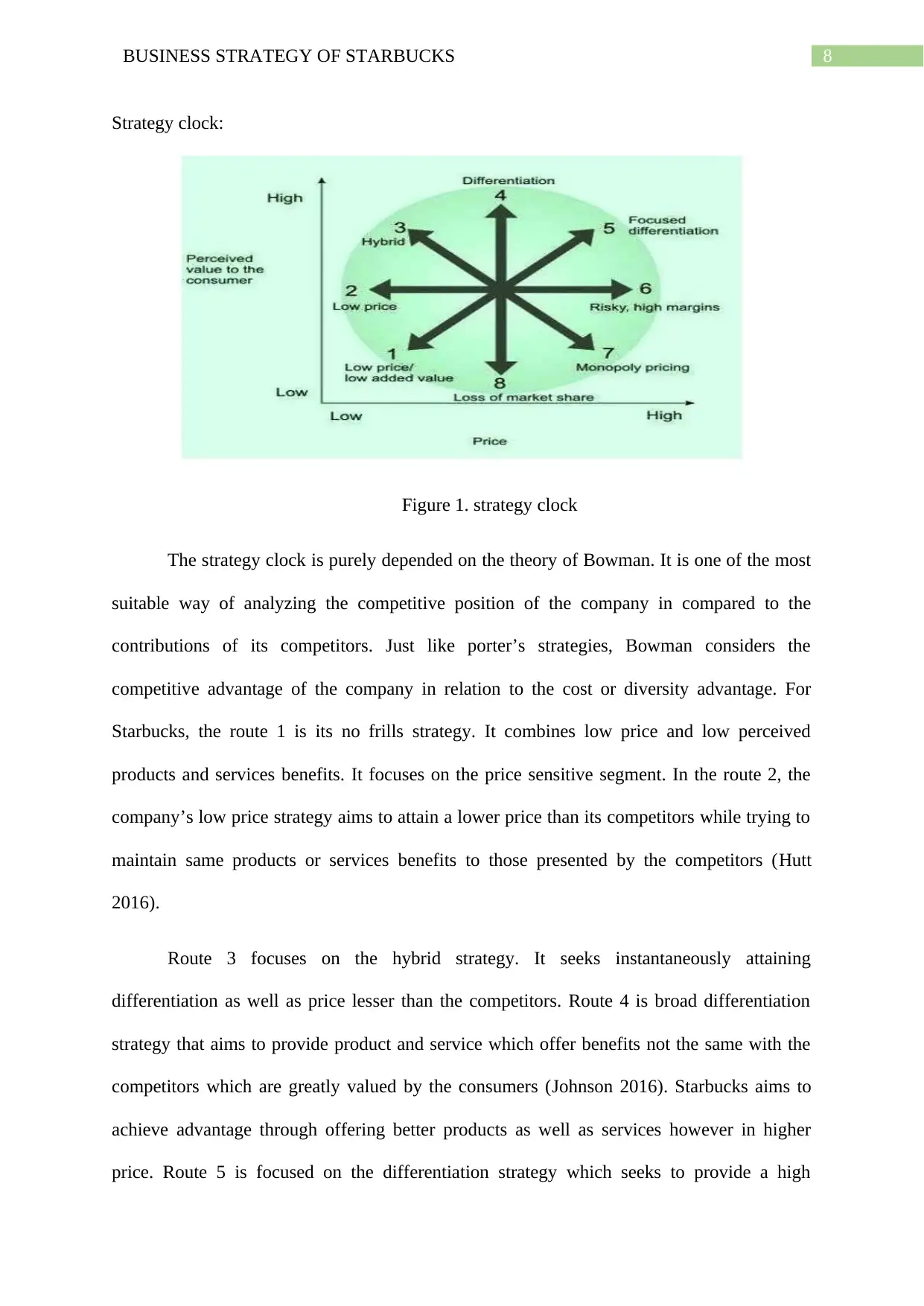
8BUSINESS STRATEGY OF STARBUCKS
Strategy clock:
Figure 1. strategy clock
The strategy clock is purely depended on the theory of Bowman. It is one of the most
suitable way of analyzing the competitive position of the company in compared to the
contributions of its competitors. Just like porter’s strategies, Bowman considers the
competitive advantage of the company in relation to the cost or diversity advantage. For
Starbucks, the route 1 is its no frills strategy. It combines low price and low perceived
products and services benefits. It focuses on the price sensitive segment. In the route 2, the
company’s low price strategy aims to attain a lower price than its competitors while trying to
maintain same products or services benefits to those presented by the competitors (Hutt
2016).
Route 3 focuses on the hybrid strategy. It seeks instantaneously attaining
differentiation as well as price lesser than the competitors. Route 4 is broad differentiation
strategy that aims to provide product and service which offer benefits not the same with the
competitors which are greatly valued by the consumers (Johnson 2016). Starbucks aims to
achieve advantage through offering better products as well as services however in higher
price. Route 5 is focused on the differentiation strategy which seeks to provide a high
Strategy clock:
Figure 1. strategy clock
The strategy clock is purely depended on the theory of Bowman. It is one of the most
suitable way of analyzing the competitive position of the company in compared to the
contributions of its competitors. Just like porter’s strategies, Bowman considers the
competitive advantage of the company in relation to the cost or diversity advantage. For
Starbucks, the route 1 is its no frills strategy. It combines low price and low perceived
products and services benefits. It focuses on the price sensitive segment. In the route 2, the
company’s low price strategy aims to attain a lower price than its competitors while trying to
maintain same products or services benefits to those presented by the competitors (Hutt
2016).
Route 3 focuses on the hybrid strategy. It seeks instantaneously attaining
differentiation as well as price lesser than the competitors. Route 4 is broad differentiation
strategy that aims to provide product and service which offer benefits not the same with the
competitors which are greatly valued by the consumers (Johnson 2016). Starbucks aims to
achieve advantage through offering better products as well as services however in higher
price. Route 5 is focused on the differentiation strategy which seeks to provide a high
⊘ This is a preview!⊘
Do you want full access?
Subscribe today to unlock all pages.

Trusted by 1+ million students worldwide
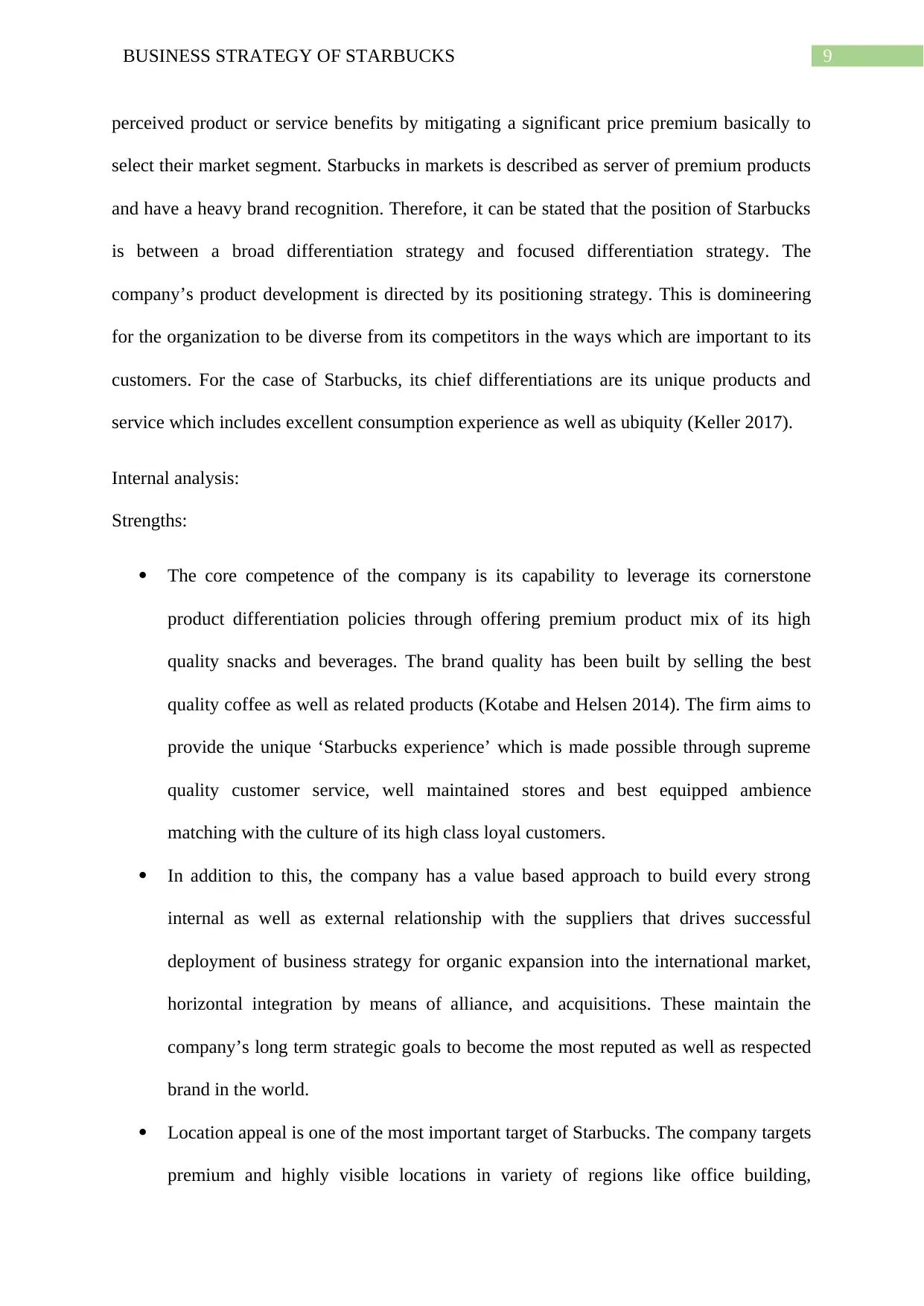
9BUSINESS STRATEGY OF STARBUCKS
perceived product or service benefits by mitigating a significant price premium basically to
select their market segment. Starbucks in markets is described as server of premium products
and have a heavy brand recognition. Therefore, it can be stated that the position of Starbucks
is between a broad differentiation strategy and focused differentiation strategy. The
company’s product development is directed by its positioning strategy. This is domineering
for the organization to be diverse from its competitors in the ways which are important to its
customers. For the case of Starbucks, its chief differentiations are its unique products and
service which includes excellent consumption experience as well as ubiquity (Keller 2017).
Internal analysis:
Strengths:
The core competence of the company is its capability to leverage its cornerstone
product differentiation policies through offering premium product mix of its high
quality snacks and beverages. The brand quality has been built by selling the best
quality coffee as well as related products (Kotabe and Helsen 2014). The firm aims to
provide the unique ‘Starbucks experience’ which is made possible through supreme
quality customer service, well maintained stores and best equipped ambience
matching with the culture of its high class loyal customers.
In addition to this, the company has a value based approach to build every strong
internal as well as external relationship with the suppliers that drives successful
deployment of business strategy for organic expansion into the international market,
horizontal integration by means of alliance, and acquisitions. These maintain the
company’s long term strategic goals to become the most reputed as well as respected
brand in the world.
Location appeal is one of the most important target of Starbucks. The company targets
premium and highly visible locations in variety of regions like office building,
perceived product or service benefits by mitigating a significant price premium basically to
select their market segment. Starbucks in markets is described as server of premium products
and have a heavy brand recognition. Therefore, it can be stated that the position of Starbucks
is between a broad differentiation strategy and focused differentiation strategy. The
company’s product development is directed by its positioning strategy. This is domineering
for the organization to be diverse from its competitors in the ways which are important to its
customers. For the case of Starbucks, its chief differentiations are its unique products and
service which includes excellent consumption experience as well as ubiquity (Keller 2017).
Internal analysis:
Strengths:
The core competence of the company is its capability to leverage its cornerstone
product differentiation policies through offering premium product mix of its high
quality snacks and beverages. The brand quality has been built by selling the best
quality coffee as well as related products (Kotabe and Helsen 2014). The firm aims to
provide the unique ‘Starbucks experience’ which is made possible through supreme
quality customer service, well maintained stores and best equipped ambience
matching with the culture of its high class loyal customers.
In addition to this, the company has a value based approach to build every strong
internal as well as external relationship with the suppliers that drives successful
deployment of business strategy for organic expansion into the international market,
horizontal integration by means of alliance, and acquisitions. These maintain the
company’s long term strategic goals to become the most reputed as well as respected
brand in the world.
Location appeal is one of the most important target of Starbucks. The company targets
premium and highly visible locations in variety of regions like office building,
Paraphrase This Document
Need a fresh take? Get an instant paraphrase of this document with our AI Paraphraser
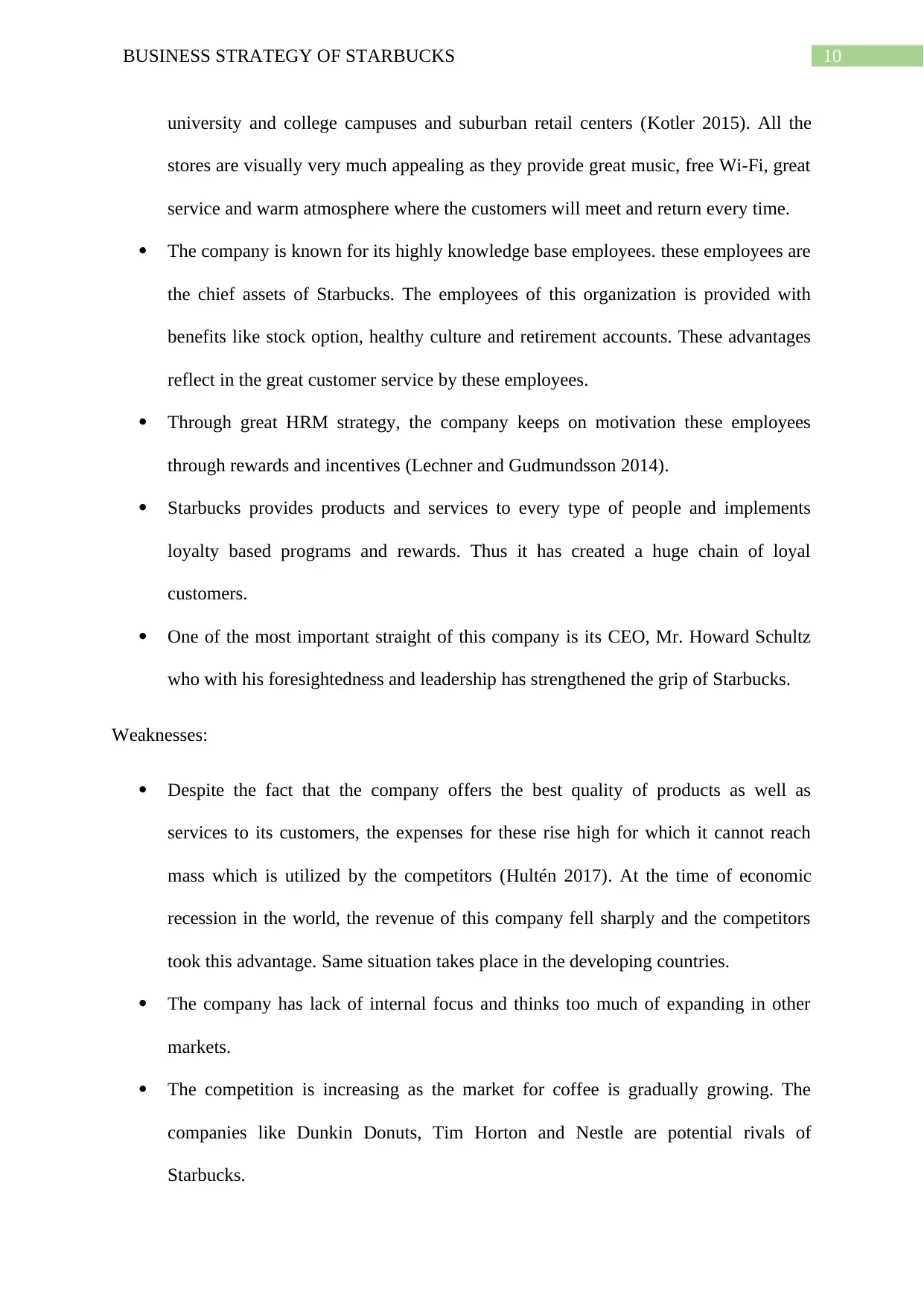
10BUSINESS STRATEGY OF STARBUCKS
university and college campuses and suburban retail centers (Kotler 2015). All the
stores are visually very much appealing as they provide great music, free Wi-Fi, great
service and warm atmosphere where the customers will meet and return every time.
The company is known for its highly knowledge base employees. these employees are
the chief assets of Starbucks. The employees of this organization is provided with
benefits like stock option, healthy culture and retirement accounts. These advantages
reflect in the great customer service by these employees.
Through great HRM strategy, the company keeps on motivation these employees
through rewards and incentives (Lechner and Gudmundsson 2014).
Starbucks provides products and services to every type of people and implements
loyalty based programs and rewards. Thus it has created a huge chain of loyal
customers.
One of the most important straight of this company is its CEO, Mr. Howard Schultz
who with his foresightedness and leadership has strengthened the grip of Starbucks.
Weaknesses:
Despite the fact that the company offers the best quality of products as well as
services to its customers, the expenses for these rise high for which it cannot reach
mass which is utilized by the competitors (Hultén 2017). At the time of economic
recession in the world, the revenue of this company fell sharply and the competitors
took this advantage. Same situation takes place in the developing countries.
The company has lack of internal focus and thinks too much of expanding in other
markets.
The competition is increasing as the market for coffee is gradually growing. The
companies like Dunkin Donuts, Tim Horton and Nestle are potential rivals of
Starbucks.
university and college campuses and suburban retail centers (Kotler 2015). All the
stores are visually very much appealing as they provide great music, free Wi-Fi, great
service and warm atmosphere where the customers will meet and return every time.
The company is known for its highly knowledge base employees. these employees are
the chief assets of Starbucks. The employees of this organization is provided with
benefits like stock option, healthy culture and retirement accounts. These advantages
reflect in the great customer service by these employees.
Through great HRM strategy, the company keeps on motivation these employees
through rewards and incentives (Lechner and Gudmundsson 2014).
Starbucks provides products and services to every type of people and implements
loyalty based programs and rewards. Thus it has created a huge chain of loyal
customers.
One of the most important straight of this company is its CEO, Mr. Howard Schultz
who with his foresightedness and leadership has strengthened the grip of Starbucks.
Weaknesses:
Despite the fact that the company offers the best quality of products as well as
services to its customers, the expenses for these rise high for which it cannot reach
mass which is utilized by the competitors (Hultén 2017). At the time of economic
recession in the world, the revenue of this company fell sharply and the competitors
took this advantage. Same situation takes place in the developing countries.
The company has lack of internal focus and thinks too much of expanding in other
markets.
The competition is increasing as the market for coffee is gradually growing. The
companies like Dunkin Donuts, Tim Horton and Nestle are potential rivals of
Starbucks.
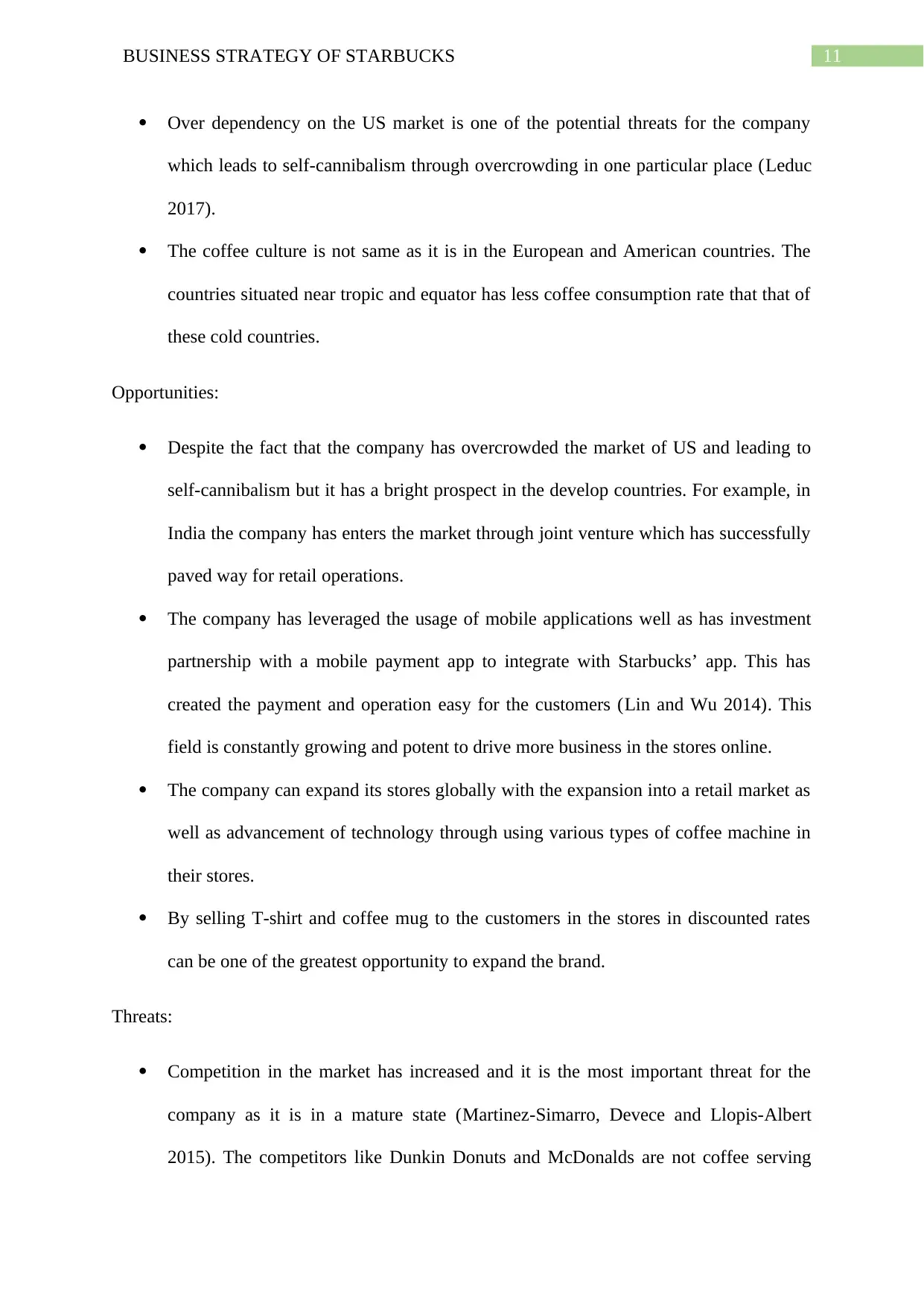
11BUSINESS STRATEGY OF STARBUCKS
Over dependency on the US market is one of the potential threats for the company
which leads to self-cannibalism through overcrowding in one particular place (Leduc
2017).
The coffee culture is not same as it is in the European and American countries. The
countries situated near tropic and equator has less coffee consumption rate that that of
these cold countries.
Opportunities:
Despite the fact that the company has overcrowded the market of US and leading to
self-cannibalism but it has a bright prospect in the develop countries. For example, in
India the company has enters the market through joint venture which has successfully
paved way for retail operations.
The company has leveraged the usage of mobile applications well as has investment
partnership with a mobile payment app to integrate with Starbucks’ app. This has
created the payment and operation easy for the customers (Lin and Wu 2014). This
field is constantly growing and potent to drive more business in the stores online.
The company can expand its stores globally with the expansion into a retail market as
well as advancement of technology through using various types of coffee machine in
their stores.
By selling T-shirt and coffee mug to the customers in the stores in discounted rates
can be one of the greatest opportunity to expand the brand.
Threats:
Competition in the market has increased and it is the most important threat for the
company as it is in a mature state (Martinez-Simarro, Devece and Llopis-Albert
2015). The competitors like Dunkin Donuts and McDonalds are not coffee serving
Over dependency on the US market is one of the potential threats for the company
which leads to self-cannibalism through overcrowding in one particular place (Leduc
2017).
The coffee culture is not same as it is in the European and American countries. The
countries situated near tropic and equator has less coffee consumption rate that that of
these cold countries.
Opportunities:
Despite the fact that the company has overcrowded the market of US and leading to
self-cannibalism but it has a bright prospect in the develop countries. For example, in
India the company has enters the market through joint venture which has successfully
paved way for retail operations.
The company has leveraged the usage of mobile applications well as has investment
partnership with a mobile payment app to integrate with Starbucks’ app. This has
created the payment and operation easy for the customers (Lin and Wu 2014). This
field is constantly growing and potent to drive more business in the stores online.
The company can expand its stores globally with the expansion into a retail market as
well as advancement of technology through using various types of coffee machine in
their stores.
By selling T-shirt and coffee mug to the customers in the stores in discounted rates
can be one of the greatest opportunity to expand the brand.
Threats:
Competition in the market has increased and it is the most important threat for the
company as it is in a mature state (Martinez-Simarro, Devece and Llopis-Albert
2015). The competitors like Dunkin Donuts and McDonalds are not coffee serving
⊘ This is a preview!⊘
Do you want full access?
Subscribe today to unlock all pages.

Trusted by 1+ million students worldwide
1 out of 24
Related Documents
Your All-in-One AI-Powered Toolkit for Academic Success.
+13062052269
info@desklib.com
Available 24*7 on WhatsApp / Email
![[object Object]](/_next/static/media/star-bottom.7253800d.svg)
Unlock your academic potential
Copyright © 2020–2025 A2Z Services. All Rights Reserved. Developed and managed by ZUCOL.





